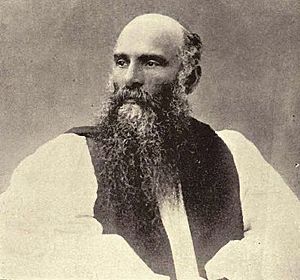William Ridley (bishop) facts for kids
Quick facts for kids William Ridley |
|
|---|---|
| Bishop of Caledonia | |
 |
|
| Church | Church of England |
| See | Caledonia |
| In Office | 1879–1905 |
| Personal details | |
| Born | c. 1836 Devonshire, England |
| Died | 25 May 1911 England |
William Ridley (born in 1836, died in 1911) was an English missionary who worked for the Church of England. He became a special leader called a Bishop in Canada, specifically for a region known as Caledonia.
Contents
Early Life and Missionary Work
William Ridley grew up in Brixham, Devonshire, England. His father was a stonemason. Before becoming a missionary, William worked as a carpenter. He then went to a special school run by the Church Missionary Society.
In 1866, he was sent to Peshawar, India, to work as a missionary among the Afghan people. This was a very difficult time for him. He faced illnesses and felt discouraged, and his time there lasted only three years. After that, he worked as a priest in Dresden from 1867 to 1872.
Becoming a Bishop in Canada
After returning to England, Ridley became a vicar (a type of priest) in Huddersfield from 1874 to 1879. In 1879, he was chosen to be the Bishop of the new Diocese of Caledonia. This area was in northern British Columbia, Canada.
He was officially made a bishop on July 25 at St Paul's Cathedral in London. Soon after, he and his wife, Jane, traveled to Canada. His main job was to make sure that the missions (religious centers) in the area followed the rules of the Anglican Church.
Conflict with William Duncan
Bishop Ridley's new role quickly led to disagreements with William Duncan. Duncan was a very influential lay missionary (someone who is not a priest but works for the church). He ran a Christian community called Metlakatla for the Tsimshian people.
Duncan had his own ideas about how the church should be run. He didn't want to offer Holy Communion to his followers. He believed it might remind them of old customs they had given up. Duncan also disagreed with Ridley's plan to translate religious teachings into the Tsimshian language.
The Ridley Orthography
Despite Duncan's objections, Ridley worked with Odille Morison, a Tsimshian woman, to translate the catechism (a book of religious instructions) into the Tsimshian language. This translation created the first practical spelling system for the language, which became known as the "Ridley orthography."
The Feud Escalates
The conflict between Ridley and Duncan became very intense. At one point, Ridley tried to remove Duncan from Metlakatla. This led to a heated argument and almost a physical fight with Paul Legaic, a key Tsimshian chief who supported Duncan.
Because of these disagreements, William Duncan was removed from the Church Missionary Society in 1881. Duncan then started his own independent church in Metlakatla. In 1887, Duncan and about 800 of his followers moved to Alaska. There, they founded a new community called "New" Metlakatla, Alaska.
After Duncan left, about 100 people remained in "Old Metlakatla." Bishop Ridley was then in charge of this community.
Later Years and Legacy
In July 1901, a large fire destroyed St. Paul's Church in Metlakatla. This church was built by Duncan in 1874 and was said to be the largest church north of San Francisco. Some people believed the fire was started by a group of Tsimshians from Alaska, possibly on Duncan's orders.
This tragic fire deeply affected Bishop Ridley. It led to his early retirement, and he returned to England in 1905. He died on May 25, 1911, in England.
Today, Ridley Island, an industrial area near Prince Rupert, British Columbia, is named after him. Many Tsimshian families in Metlakatla, Alaska, and in Hartley Bay and Kitkatla, British Columbia, also carry the Ridley surname, honoring his connection to their communities.

